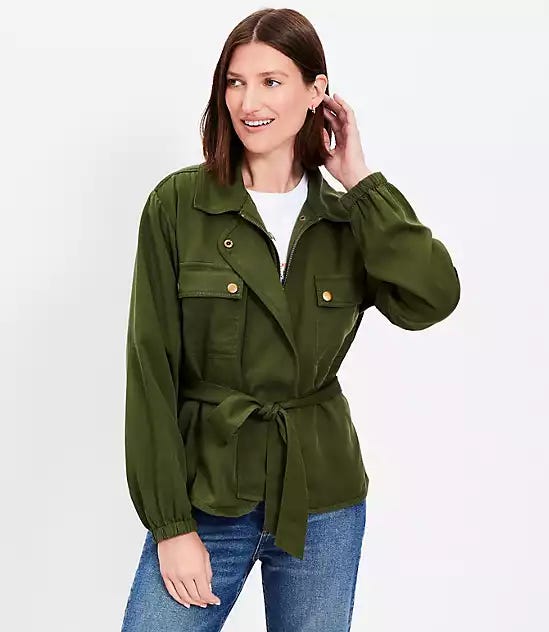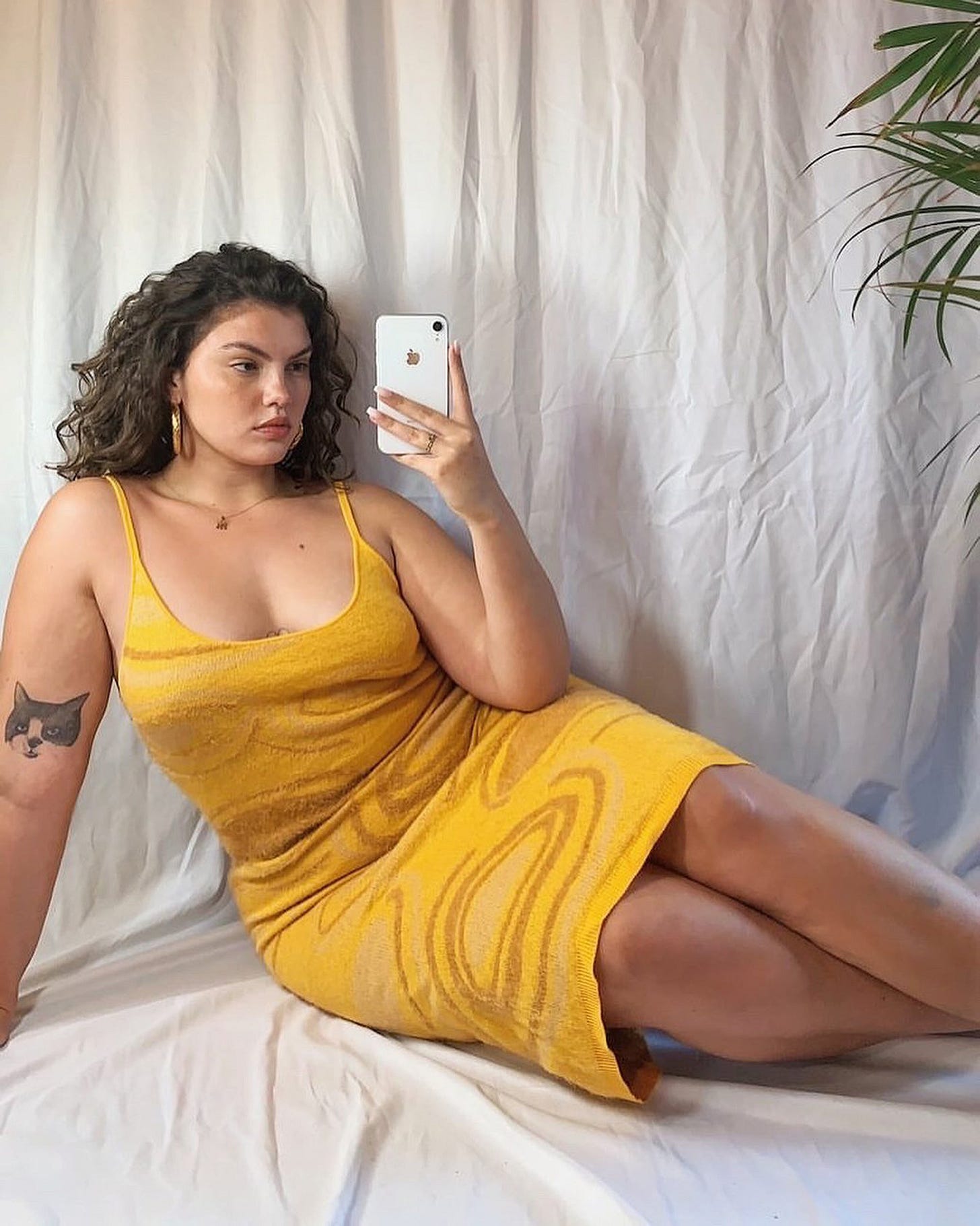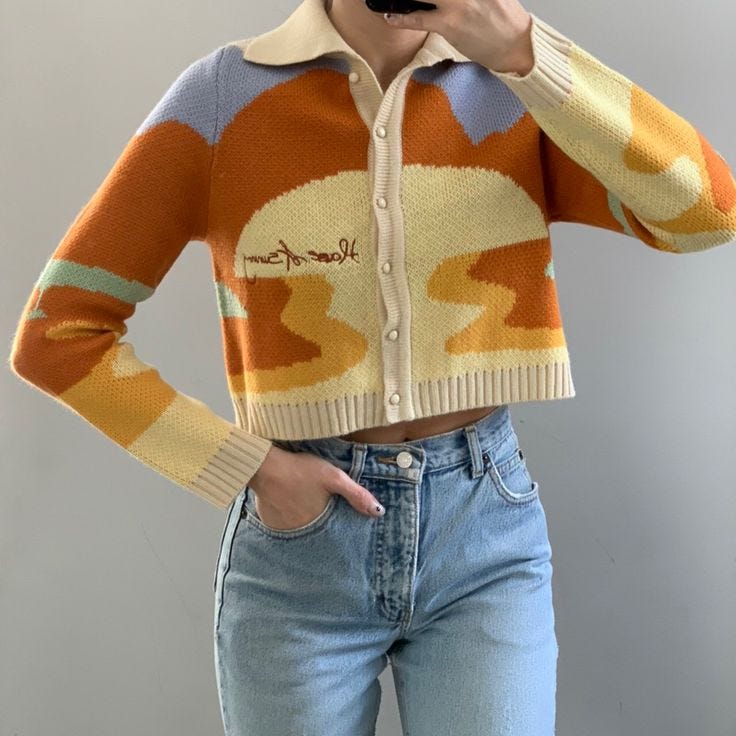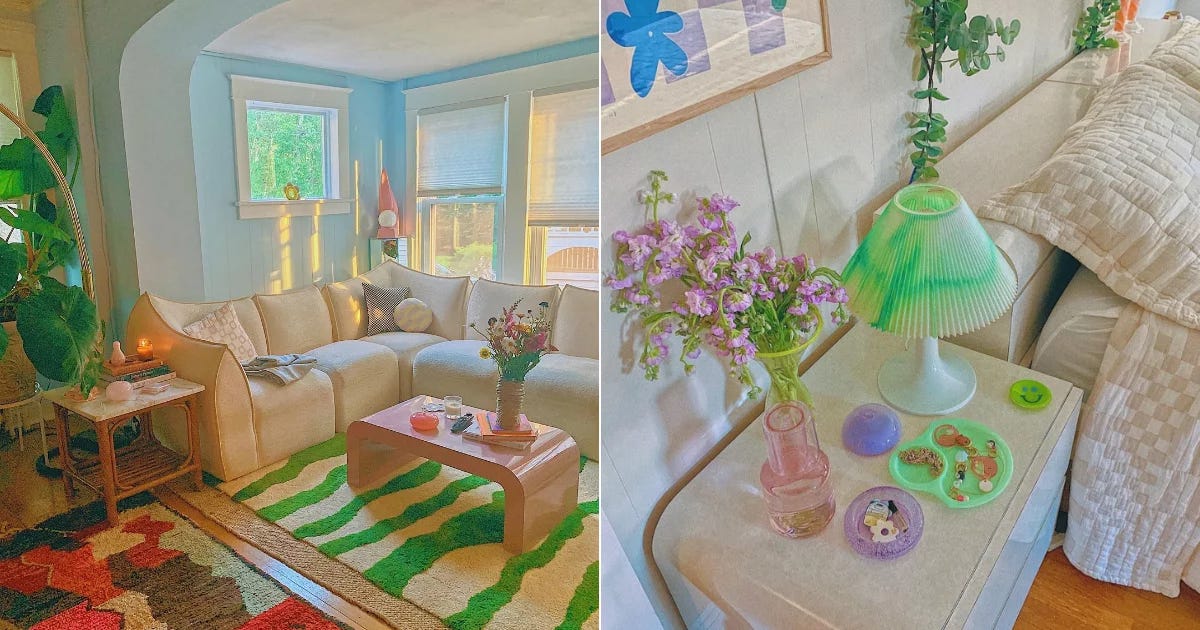Why Did Clothes Look Like...That...in 2021?
The ubiquitous aesthetic that embodied post-2020 insanity
Even if you don’t pay a lot of attention to fashion, you may have noticed that in the year following covid lockdowns, everything looked…well, a bit like this:
While I know many people are quick to point out that the United States “never really had a lockdown,” I think it’s safe to say that a lot of people spent more time at home in 2020 than they would have otherwise. For some people, myself included, this was pretty draconian (I was pregnant and gave birth in 2020, which had a lot to do with my level of covid-related anxiety. Also, preexisting OCD.) I didn’t leave the house at all from March 2020 until May of 2021, for anything other than medical appointments.
While there was a lot to be genuinely sad about in 2020, I found myself a bit sad about something very frivolous, and guilty for even caring about it—fashion. I basically only wore one pair of shoes all year, practical soot-black Allbirds sneakers, solely for going to the doctor. Around the house, I wore spitup-stained sweatshirts and joggers. My heels literally gathered dust. I started to wonder if fashion was just going to be a remnant of the Before Times. My constant doomscrolling of Insane Covid Twitter, which at the time insisted a vaccine would actually be worse for you than covid itself—didn’t exactly help.
But then I got vaccinated, and I started leaving the house more often, and I noticed that something major had happened with fashion.
First of all, for context: the late 2010s was one of the worst times for fashion, if you like things to be pretty or interesting. Everything was about “practicality.” This was the peak of Everlane/Cuyana. Fashion was ruled by people who ostensibly hated fashion. Everyone wanted a “capsule wardrobe,” with the goal of being as colorless, interchangeable and unremarkable as possible. Reddit’s r/femalefashionadvice was extremely active, with every user basically asking how to be perceived as little as possible. MM LaFleur touted itself a brand for “professional women who hate to shop” with the tagline “your clothes should be the least interesting thing about you.” Of course, there’s something to be said for women who are uninterested in fashion having an avenue for dressing easily and acceptably, without much flair or pizzazz—but we already have that, it’s called Ann Taylor LOFT.
As a woman who likes red, pink, yellow, bows, plaid, polka dots and houndstooth, this era of fashion was incredibly depressing, especially when I saw no-frills, all-taupe “fashion” repeatedly lumped in with feminism, as if there was some kind of progressive enlightenment associated with dressing like Elizabeth Holmes. Increasingly, I saw clothing lines touted as “unisex” (a marketing scheme that really means “men’s clothes that women can also wear if they want.”) I cringed as the zeitgeist repeatedly declared that minimalism was Here To Stay—not a trend in and of itself. The San Francisco chronicle asked if 2018 was “The Year of Feminist Fashion,” which of course, meant a narrowly-defined idea of fashion that isn’t terribly pretty or fun. I’ve written in the past about how it’s impossible to decouple our desire to be pretty with a desire to attract men or at least adhere to beauty standards, but that doesn’t mean it’s bad to want to look pretty, only that it’s deeply ingrained in our society.
It suddenly felt embarrassing to like fashion just because it’s fun, and not because it’s making some kind of groundbreaking statement about “weaponizing femme aesthetics to counter the male gaze” (I have no idea, whatever.) Look, I just like pretty things. I like Bridgerton. Just let me have fun. And sure, nobody was disallowing me to have fun, but staying on-trend was incredibly difficult when nothing I liked was trending. And yes, you don’t have to follow trends (and to this day I ignore many of them) but for people who enjoy fashion, there’s also something kind of unfulfilling about perpetually dressing like the bygone era you preferred, and the stuff on the horizon never being your taste.
Anyway, I noticed when I reemerged from my covid cave in 2021, that clothes had really changed. Sure, a lot of people were wearing athleisure or jeans, but I was seeing lots of bright-colored knits, funky patterns, 2000s inspired low-rise pants with butterflies on them, bright pink fuzzy crop tops right out of Clueless. And it made sense to me—for many people, 2020 was a year inside a cocoon where the Madewell caterpillar hibernated. In 2021, she emerged as a House of Sunny butterfly.
House of Sunny, of course, is a great example of 2021 fashion—an aesthetic that has since been named “Avant Basic.” This incorporates an interesting mix of 2000s-inspired cuts (baggy cargo pants, crop tops, hoodies, etc.) with psychedelic patterns- wavy checkboard, the iconic circles and rings on the House of Sunny Hockney dress. The best part of Avant Basic is there are no rules. You can mix colors, patterns, fits, the way you want. You can wear sneakers with dresses, you can wear heels with cargo shorts. You can be sexy, or cover everything. Just be interesting, dammit.
I couldn’t help but notice something very on-point about fashion looking a bit (lovably) insane around the same time that people were all a bit insane. You’d walk down the street in your Austin Powersy bright orange bellbottoms and see a throwdown fight at a nearby Qdoba because a customer was asked to wear a surgical mask to order their food, despite being allowed to remove it to eat. Then someone else would pop in and declare that the person enforcing the mask was a cop, and ACAB. Everything was a bit crazy, and the clothes matched.
Avant Basic even made its way into interior design. I never saw an apartment like this in real life, but they seemed to be all over TikTok, rented by chic, single twenty-something women in New York City who drank matcha every morning alongside their bowl of chia pudding with honey and almonds.
Another brand that exemplified Avant Basic was Lisa Says Gah—a house brand and an aggregator of independent designers. While House of Sunny was known for the groovy, trippy patterns and retro-inspired designs, Lisa Says Gah quickly carved a niche as the main brand for food-printed items, most specifically their Italian Summer collection, which is still going strong and sold out repeatedly during Tomato Girl Summer.
Of course, like all trends, Avant Basic eventually got oversaturated (although Lisa Says Gah is still going strong with various food prints.) The once-hot Hockney dress is now readily available on luxury second hand retailer TheRealReal, discarded by all the fashion girlies who bought it in 2021. But fashion has not returned to the drab pseudo-political minimalism of the late 2010s, thank goodness. We got a brief spurt of minimalism in the form of That Girl—the smoothie-making, Aritzia-matching-sweatpants-set wearing woman who wakes up at 5 AM to do a cold plunge and set her intention for the day—but even that aesthetic was deeply visual and fun, with cute bullet journals, lilac lavender sweatshirts, gold hoop earrings, and bubblegum pink blush.
And luckily, things are still interesting. Since the rise of Avant Basic, we’ve been seeing lots of micro-trends from tenniscore, to coquette, to old money/quiet luxury, to gorpcore. I’ve been keeping my eyes on the office siren aesthetic despite it being incredibly impractical for my lifestyle—it’s just fun! And while those trends might give way to lots of Shein-buying, I like to think that the rapid cycling of on-trend aesthetics encourages more people to figure out what they like and enjoy trends in a purely opt-in way, especially via second hand retailers like Depop and Poshmark, as opposed to feeling the need to buy an entire wardrobe based around clowncore.










I have a lot of thoughts about this topic, and I’d like to add that I think that generational shifts also brought this aesthetic into the mainstream.
I’m a zillennial who leans more millennial in spirit, but my sister and her peer group are full-fledged gen Z. They started dressing like this in the years leading up to 2020. There are two key factors which in my mind contributed to the youth dressing like this: a reaction against the existing trends and what they seemed to represent, and thrifting.
In the late 2010s, much of the clothing that was marketed towards youngish women fit one of two general molds: bland, capsule wardrobe-ready clothing, or sexy instagram baddie clothing. Many Gen Z girls were decidedly not into it. To them, it felt like millennial female fashion was beige and bland and corporate, or sultry, hyper-feminine, and Kardashian-obsessed. What were the young girls, who liked color and patterns, wanted to express individuality, didn’t want to look overly sexy, and weren’t concerned about what might fly in an office to do?
Thrifting. Gen Z embraced buying weird sweaters from the 80s, tie-dye t-shirts covered in butterflies, bold print pants, chunky 90s shoes. To Gen Z, thrift stores sold clothing that was interesting, kitschy, and less expensive than brand new clothing. It wasn’t corporate, consumerist, heteronormative, or serious, it was quirky, rebellious, accessible, and youthful.
Gradually, I think the clothing industry started noticing. You saw the rise of maximalist brands, and existing brands started incorporating those elements into their designs. In the second season of The White Lotus, the Gen Z character Portia dressed in a distinctively avant-basic style, and a lot of older people looked on and asked why she was dressed like that. She was dressed the way my sister and her friends dress. I asked my sister what she thought of Portia’s wardrobe, and she said that Portia just dressed normally for someone in that generation and would fit in perfectly in her friend group.
It was a reaction against the minimalism that dominated fashion in the years prior, but it was also a reflection of a new generation of girls aging into their teens and twenties.
"I didn’t leave the house at all from March 2020 until May of 2021, for anything other than medical appointments."
You didn't even go for a walk? No going outside at all? That must have been terrible for you if so. I am so sorry that some people felt they had to go to these extremes